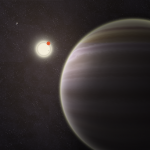Kepler’s follow-up observers confirm new discoveries
More than 2,300 exoplanet candidate discoveries have made it the most prolific planet hunter in history. But even NASA’s Kepler mission needs a little help from its friends.

A single Kepler observation alone is often not enough to prove that the telescope has found an exoplanet, said Nick Gautier, the mission’s deputy project scientist at NASA’s Jet Propulsion Laboratory, Pasadena, Calif., who coordinated and continues to help run Kepler’s robust follow-up program.
Kepler finds exoplanets by watching for worlds that move directly between the telescope and their host stars. As they do this, they block a tiny fraction of the star’s light, an event astronomers call a “transit.”
Continue reading “Kepler Gets a Little Help From Its Friends”
